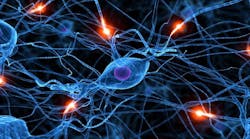By Miky Lee, Craig Hillman, and Duksoo Kim
Military and avionics use of optoelectronics-especially displays-has exploded in recent years as the military’s implementation of commercial off-the-shelf (COTS) components continues to grow. Lasers allow for ever-more-precise targeting, optical sensors provide quality information on the surrounding environment, and liquid-crystal displays (LCDs) are lighter than the cathode-ray tubes (CRTs) they replace.
Optical circuits, in fact, provide an opportunity for meeting military and avionics performance needs without the reliability tradeoffs expected of electronics within the next few years. However, predicting the reliability of these products can be difficult for the reliability engineer with little experience in optoelectronic technology. Where can this engineer start?
The standard approach often relies on empirical prediction handbooks, such as MIL-STD-217 and TR-332. Yet MIL-STD-217 has not been updated in almost 10 years and is no longer appropriate for assessing the latest technology. TR-332 can suffer from similar shortcomings because of the time delay between retrieving failure information from the field, incorporating it into the handbook, and releasing the latest reliability prediction figures.
Some companies have chosen to develop their own reliability predictions based on field returns, but the low production levels of most avionics and military suppliers tend to preclude this approach. There are even more shortcomings to the empirical prediction method when it comes to optoelectronics reliability.
First, the typical failure mode of light-emitting diodes (LEDs) and laser diodes (LDs) is a gradual degradation of the power output over time. The TR-332 standard, moreover, provides information only in terms of a steady-state failure rate. Although LEDs or lasers degrade gradually in most cases, sudden failures have been observed due to dislocation growth from the outside the active regions, p-n junction destruction, dislocation growth from the facet oxidation region, or the interface between the facet and the dielectric coating film and catastrophic optical damage.
Second, users familiar with LEDs and LDs have long realized that reliability, especially with regard to degradation rates, often depends on the component supplier. Awareness of these two severe limitations requires focus life testing based on a fundamental understanding of failure mechanisms.
Defining failures
Users of LEDs and LDs should define the power output that would result in failure in their system and then use physics-of-failure (PoF)-based models to predict time to failure. The definition of failure is critical-when an optoelectronic device officially fails varies among manufacturers and users.
One method of determining failure is to hold the driving current fixed and consider the end of life to be when the output power falls below a certain percentage, often 20 to 50 percent. Another method monitors the fall of output power and compensates by boosting the drive current to the level necessary to maintain the original power level. When the drive current reaches a predetermined relative value (such as 50 percent), the device is considered to be at the end of its useful life.
Several failure mechanisms and defects can initiate LED and LD failures. Reliability engineers should take care not to focus exclusively on the effects of temperature and current density, because this approach can lead to invalid product qualification.
Active region degradation
In the active region, the radiative recombination of injected carriers emits light. The nucleation and growth of dislocations, as well as the precipitation of host atoms, degrade the inner region. These processes require the presence of a crystal defect; accelerating this defect are injected current density, joule heating by injected and ambient carriers, and emitted light. Material selection also has an effect, as AlGaAs/GaAs is much more sensitive to this mechanism than InGaAs (P)/InP.
InGaN/GaN systems (for blue and green emission) are insensitive to defects that compare to the defects described above. Simple p-n junctions, buried heterostructures, and multiple quantum wells can comprise active regions. At the interface of these structures, the changes of chemical compositions or even lattice parameters are inevitable. On high electrical injections, the chemical components can electromigrate into the other regions. The structural changes generate crystalline defects like dislocations and point defects, which act as nonradiative centers that hinder the natural radiative decay and produce more heat within the active layer.
Electrode degradation
Degraded electrodes in LEDs and LDs generally correspond to p-side electrodes; ordinary devices are composed of n-type substrates and the p-side electrodes exist near the active region of these devices. For devices with a p-type substrate, the corresponding electrode is the n-side electrode.
The primary cause of electrode degradation is mainly metal diffusion onto the inner region, or so-called outer diffusion, of semiconductor material. Diffusion increases as the injected current and ambient temperature increase.
Unfortunately, the selection of proper Ohmic p-side electrode materials for InGaN/GaN systems is quite difficult because of the large bandgap of p-type GaN. Because the electrode should have smaller interdiffusion coefficient of constituents, engineers sometimes apply the barrier layer to sustain electromigration effects. Current-crowding issues in high-power LEDs and LDs are more problematic.
To solve this issue, reliability engineers need the proper electrode design and vertical electrical current flow. Some electrodes like transparent conducting oxide (indium tin oxide, ITO) and reflective metals (silver) hold several problems such as electromigrations and thermal instabilities.
Facet Degradation is a serious problem when AlGaAs/GaAs LDs emit visible light, but it is not an issue in nominal LEDs or InGaAsP LDs. Oxidation through a photo-assisted reaction at the facet leads to increased threshold currents, and thus reduced laser lifetimes. Another mode of facet failure is catastrophic optical-better known as COD. When light output power exceeds a critical level, the facet melts. Handling damage, contamination, and defects can initiate failure in optoelectronic devices that are often resistant to facet degradation.
Thermal runaway
The amount of heat that operation generates requires systems designers to bond LEDs and LDs to a heat sink or substrate, often with a solder attach. If voids in the solder attach create an insufficient thermal path, the resulting hot spots eventually will lead to thermal runaway and failure.
Thermal runaway due to solder voiding often dominates failure occurrences in LDs within 10,000 hours of operation. Voiding can occur because of poor processing conditions or metal diffusion at the interface (i.e., Kirkendall voiding). Voiding can also initiate due to electromigration. When a sufficiently high current density is available in the metal, vacancies and metal ions will migrate towards opposite poles, leading to void formation (vacancies), crystals, hillocks, and whiskers.
Whisker growth, which can come about from internal strain, temperature, humidity, and material properties, usually happens near the bond between the solder and the heat sink and can lead to electrical short circuits.
EOS/ESD
Semiconductors are sensitive to damage by electrostatic discharge (ESD). The failure modes due to ESD can be sudden failure, parametric shifts, or even latent damage leading to degradation during subsequent operation. As described in MIL STD 883-Method 3015, the sensitivity of semiconductor lasers to ESD damage is greater than 100 volts on the “human body model” test.
Reverse discharge of electrical overstress (EOS) and ESD is more problematic for LEDs and LDs. Designers sometimes can apply a Zener diode or Schottky barrier to achieve specific ratings of ESD classification. Most commercial InGaN/GaN LEDs are grown on sapphire substrate, which has no electrical conduction. This leads to more residual electrical charges in the device, which make it more susceptible to EOS/ESD damage.
Thermal fatigue and shortage
A mismatched coefficient of thermal expansion between bonded parts and the bonding solder introduces stresses during temperature cycling in the manufacturing process, which can cause delamination between the attachments. When power devices undergo cycling stress, for example, the performances of hard-soldered and soft-soldered devices can be different. Thermal fatigue is observable in soft solder, while hard solder is stable against thermal cycle stressing.
Sometimes, inappropriate solder and process control can lead to a short circuit in the device. Because of relatively high wettability, tin solder can overflow a specified region of contacts and create a short.
Package-related failures can occur in encapsulant, wire, and phosphor. In encapsulants, thermomechanical stress from high temperature is the most common cause of failure in LEDs. If the temperature of the package reaches its glass transition temperature (Tg) of encapsulants, whether induced internally by electrical overdrive or externally by high ambient temperature, the epoxy starts to expand rapidly. The mismatch of thermal expansion characteristics in the internal components of the LED can cause the mechanical damage to LED.
At extremely cold temperatures, the lens epoxy can crack. The junction temperature due to internal joule heating and nonradiative reaction, goes up to 150 degrees Celsius, and causes epoxy yellowing, which changes optical power or color. If the refractive index of encapsulant does not match that of the semiconductor material, the generated light is trapped within the semiconductor and it can create another heat source.
Wire-bond breakage or detachment and die-attach strength loss are due to overheated epoxy. These problems, in turn, cause a delamination between the chip and the epoxy.
Mechanical stress from lead wires is another failure mechanism because they can generate open circuits inside the device. Inappropriate pressure, position, and direction applied to lead wire soldering can add stress at normal operating temperatures, as can leads bent too close to the body of the LED.
Most of white LEDs use yellow or red/green phosphors, which are susceptible to thermal degradation. When designers mix two or more different phosphors, each constituent should have compatible lifetime and degradation behavior to keep the status of color. The color temperature and purity level of phosphors also degrade over time.
Miky Lee is the president and Craig Hillman is the CEO of DfR Solutions, an electronics reliability and quality consultancy in College Park, Md. They can be reached by e-mail at [email protected] and [email protected]. Duksoo Kim is a senior research engineer at Samsung ElectroMechanics, a supplier of a wide range of optoelectronic components and technology. He can be reached by e-mail at [email protected].


